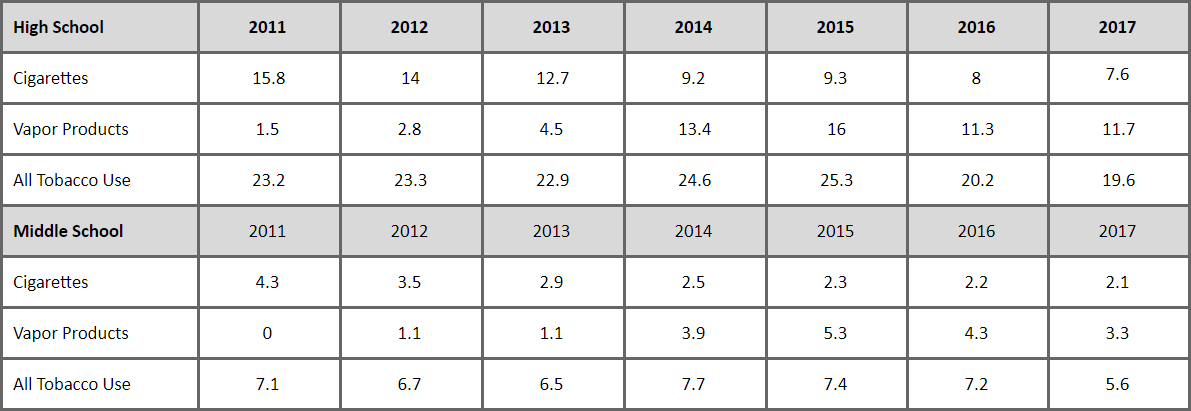On Wednesday, September 12, 2018, FDA commissioner Dr. Scott Gottlieb announced enforcement actions to be taken in the wake of unpublished “preliminary data” showing an “epidemic rise” in vaping among young people. Although the new data are not publicly available, Dr. Gottlieb is referencing it as justification for drastic enforcement actions like banning flavors and pulling entire product lines off of retailers’ shelves. In order to avoid these penalties, FDA is requiring manufacturers to submit in writing within 60 days a detailed description of their plans to prevent youth access to the smoke-free vapor products they make and sell.
A numbers game
In his statement, Dr. Gottlieb refers to having “preliminary data” that shows an “epidemic” of vaping among young people. But it is perplexing, if not suspicious, that the FDA is threatening extreme enforcement action (e.g. removing products from the market) without releasing the data. It’s especially curious given that the public data from the annual National Youth Tobacco Surveys (NYTS), 2011 – 2017, clearly shows that youth use of vapor products, cigarettes, and tobacco products as a whole is declining since a peak in 2015. (See graph and chart below.)

The CDC data shows that high school youth use of all tobacco products, including vapor products, dropped 22.5% from 25.3% in 2015 to 19.6% in 2017, and high school youth vaping dropped 26.8% from 16% to 11.7% during the same time period. Similarly, middle school youth use of all tobacco products and vapor products dropped 24.3% and 37.7% respectively. If, as Dr. Gottlieb suggests, there is a 75% increase in youth use of vapor products then the real question is: Has there been a similar rise in other tobacco product use? With the track record of CDC and FDA spinning statistics to hide the decline in smoking behind the rise in vaping, we are skeptical of such a pronouncement – especially when it is made without the data to back it up.
By Dr. Gottlieb’s own admission, it’s smoking that kills, not nicotine. Often overlooked is the fact that available data shows that America’s youth are continuing to gravitate away from smoking or never start to begin with. If the mysteriously undisclosed 2018 data truly reveals a dramatic increase in youth vaping since last year, how meaningful would that rise be if the smoking rates continue to decline? This is a key point that seems to be lost in the rhetoric. We won’t know the answer until we see the actual numbers, but if the data does reveal an increase in youth smoking, it is strange that Dr. Gottlieb didn’t even hint at what would be far, far more worrisome data.
The public is being misled about “use”
By using figures that include “ever use, even one puff,” the FDA can create the illusion that vaping is vastly more popular among teens than it really is. Any new product will start at zero people trying it and increase as time passes, but that doesn’t mean people will continue using the product.
For example, youth who answer that they’ve tried a vapor product in the past 30 days – even one puff from a friend or family member’s device – are labeled as “current users.” This practice is highly misleading, because a layperson could easily misunderstand “current use” to mean “daily use,” and daily use, to many people, would imply dependance or addiction. Since 2014, the NYTS survey does ask about frequency of use, but neither the CDC nor the FDA reports how many “current users” only experimented with one puff in the past 30 days vs. respondents who described daily use.
Dr Gottlieb describes an “epidemic of addiction” when, according to the National Institutes of Drug Abuse (NIDA) data, most teens use only flavored products without nicotine. In 2017, an estimated 2.1 million of 26.6 million middle and high school students tried vaping at least once in the past 30 days, yet past NIDA surveys found that only 13% of youth who tried e-cigarettes reported that the devices contained nicotine. This calculates to just 1% of all middle and high school students trying e-cigarettes with nicotine. Even if the number of youth vaping increased in 2018 by an unprecedented 200%, the number of youth using nicotine in vapor products would only rise to 2% of all students. That kind of pronouncement made by FDA, while ignoring data they already have at hand from NIDA, only serves to further panic the public without cause.

Additionally, young people who answer that they also smoke cigarettes are not asked if they started smoking before or after they first tried vaping. This is leading to many deceptive claims about vaping acting as a gateway to smoking. Researchers and tobacco control groups frequently use the NIDA survey to report that “most youth who use vapor products also smoke, so vaping may be a gateway to smoking,” yet, they are deliberately avoiding asking which product youth are using first. Furthermore, they fail to even consider the possibility that those smoking youth were already at a high risk for smoking even without ever trying vaping.
Dr. Gottlieb’s statements also make it clear that the FDA can not confirm youth “use” is rising, only that they expect their data to validate their suspicion. He also stated: “We must factor in whether these products get kids addicted to nicotine,” clearly indicating that there is a lack of certainty surrounding this issue. And yet, he places these unknown factors above the well-known risks to millions of adult smokers, strongly stating that youth nicotine use and even the slightest possibility of future nicotine addiction – regardless of whether or not they ever gravitate to smoking conventional cigarettes – is an “unacceptable trade-off” for enabling adult smokers access to effective, low-risk alternatives to smoking. Put simply, he’s willing to throw a safer alternative for tens of millions of smokers under the bus, even without evidence of any serious risk to youth.
Someone to blame
Dr. Gottlieb is placing blame for what he calls an “epidemic of addiction” (after earlier stating that nicotine addiction isn’t the greatest danger) squarely at the feet of vapor product manufacturers, for creating products that taste good and have eye-catching advertising; and major retailers and vape shops with lapses in compliance with laws forbidding sales to minors. Inexplicably, the FDA has now tasked five major vapor brand manufacturers with somehow keeping their products out of the hands of youth, although these manufacturers have less control over what happens at a store counter than parents or local law enforcement.
It’s important to note that the FDA’s own “enforcement blitz” data shows that vape shops and major retailers were not the location of most underage store sales, making up only 6.1% and 27% respectively. Furthermore, data on all underage sales including alcohol and tobacco shows that, of 135,509 inspections, fewer than 1% were found to involve sales of vapor products to minors. A whopping 78.1% of the underage purchases were actual tobacco leaf products, not vapor products.
Adult smokers like appealing flavors, too
 Dr. Gottlieb stated that he firmly believes “that new innovations that don’t use combustion, like the electronic cigarettes, offer an important opportunity for adults to transition off combustible tobacco.” He also believes in the “concept of modified risk products” and is committed to “the purpose of harm reduction.” It’s his goal to save lives by changing the trajectory of death and disease from tobacco. Yet, his actions continue to demonstrate a willingness to remove one of the most appealing and effective aspects of these products, flavors other than tobacco.
Dr. Gottlieb stated that he firmly believes “that new innovations that don’t use combustion, like the electronic cigarettes, offer an important opportunity for adults to transition off combustible tobacco.” He also believes in the “concept of modified risk products” and is committed to “the purpose of harm reduction.” It’s his goal to save lives by changing the trajectory of death and disease from tobacco. Yet, his actions continue to demonstrate a willingness to remove one of the most appealing and effective aspects of these products, flavors other than tobacco.
One of the essential points is that flavors play a key role in switching from smoking to a vastly reduced harm product. Thousands of consumer testimonials bear this out and are confirmed by results from a recent survey submitted to the docket for FDA’s advance notice of proposed rule-making on a flavors standard. If cherry, fruit, cinnamon, and orange flavors did not appeal to adult smokers, nicotine gums and lozenges would be sold only in mint and unflavored as they were originally introduced. Indeed, if adults didn’t like candy and dessert flavors, adult products would not be sold in flavors such as cotton candy, toaster pastry, chocolate milk, root beer or grape. Given that youth will experiment with adult behaviors as part of their normal growth and development, and that there is no significant flavor preference that differentiates youth from adults, the entire argument that flavors specifically target youth is a straw man argument.
What “epidemic”?
The use of the word “epidemic” is meant to convey rapid and widespread growth, or the extent of youth use of vapor products. We believe that even if youth use were increasing, it is still a public health benefit – provided that use of smoking products continues to fall. Replacing something as harmful as smoking with a product the FDA recognizes as significantly safer than smoking is a net positive for public health.
The word “epidemic” also carries with it strong, negative bias. One would not, for example, describe an increased, widespread use of condoms by teens, occurring along with a decline in overall teen sexual activity, as an “epidemic.” Ideally, teens would remain abstinent from all risky behavior, whether it’s sex, drugs, drunk driving, or smoking. However, as a society, we have generally accepted that some kids will inevitably experiment, and we shouldn’t express the same moral outrage over experimentation with lower risk activities.
In his unrealistic “zero-tolerance policy” on youth using nicotine, Dr. Gottlieb fails to see, or fails to admit, that smoking youth who switch to vapor products – and youth who would have otherwise started smoking conventional cigarettes, but choose vapor products instead – are also practicing harm reduction. He is also ignoring the consequences of such an unrealistic prohibition – namely that an unregulated, criminal black market will grow to fill the void. This is well documented in the prevalence of youth use of age-restricted products like alcohol and illegal drugs. No amount of prohibition has moved the prevalence among youth over decades of costly effort. While teen use of vapor products is certainly not ideal, the alternative is a an uptick in smoking initiation whose risks are at least 2,000% higher.
The fact is, while adult smoking rates have declined, there are still nearly 38 million adult smokers exposed to real, tangible health risks. Any risks attributed to teen vaping are largely speculative, and those risks should be weighed against the very real likelihood that most teens experimenting with vapor products, if we’re being honest, would otherwise be experimenting with smoking.
Faced with youth choosing products that, in Dr. Gottlieb’s own words, “would pose a lot less harm than smoking cigarettes,” or choosing to smoke, is there really an “epidemic” that needs fixing?
This article was originally published at CASAA
Author: KNoll-Marsh
